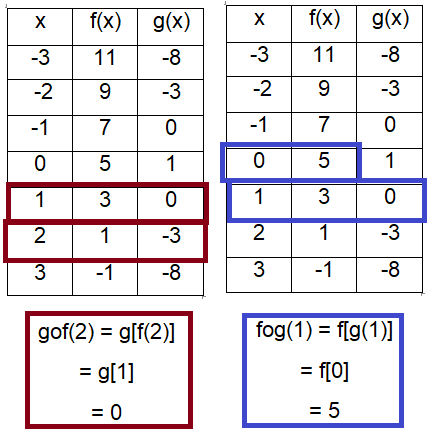FIND COMPOSITION OF TWO FUNCTIONS FROM TABLE
To find composition of two functions from the table, we have to follow the procedure given below.
Example :
From the table given below,

find i) [gof] (2) ii) [fog] (1)

Problem 1 :
The domain of function f is
{-3, -1, 0, 1, 3}
and the domain of g is
{-1, 0, 1, 3, 5}
The rule for f and g are the tabular form.

(a) Complete the following table for g ∘ f. If an entry is undefined write U.

b) What is the domain of g ∘ f ?
c) What is the domain of f ∘ g ?
Solution :
a) To complete the table,
[g ∘ f ](x) = g[f(x)]
When x = -3
[g ∘ f ](-3) = g [f(-3)]
By observing the table f, the output for -3 is -1. So, f(-3) = -1
= g [-1]
By observing the table g, the output for -1 is -2. So, g(-1) = -2
= -2
Then,
[g ∘ f ](-3) = -2
|
x = -1 [g ∘ f ](-1) = g [f(-1)] = g[0] = -1 [g ∘ f ](-1) = -1 |
x = 0 [g ∘ f ](0) = g [f(0)] = g[2] There is no input 2 in g. [g ∘ f ](0) = U |
|
x = 1 [g ∘ f ](1) = g [f(1)] = g[3] = 3 [g ∘ f ](1) = 3 |
x = 3 [g ∘ f ](3) = g [f(3)] = g[5] = 4 [g ∘ f ](3) = 4 |

b) Domain of g ∘ f is
{ -3, -1, 1, 3}
Reason of excluding 0 :
Because for the input 0, we get undefined value. So, we exclude 0 from domain.
c) To find Domain of f ∘ g, first let us find the composition.
[f ∘ g ](x) = f[g(x)]
When x = -1
[f ∘ g ](-1) = f [g(-1)]
By observing the table g, the output for -1 is -2. So, f(-1) = -2
= f [-2]
By observing the table f, we don't see the input -2 for f(x). So, it is undefined.
Then,
[f ∘ g ](-1) = U
|
x = 0 [f ∘ g ](0) = f [g(0)] = f [-1] [f ∘ g ](0) = 0 |
x = 1 [f ∘ g ](1) = f [g(1)] = f [2] [f ∘ g ](1) = Undefined |
|
x = 3 [f ∘ g ](3) = f [g(3)] = f [3] [f ∘ g ](3) = 5 |
x = 5 [f ∘ g ](5) = f [g(5)] = f [4] [f ∘ g ](5) = Undefined |
So, the domain of [f ∘ g ](x) is,
= {0, 3}
Problem 2 :
Graphs of the functions f and g are shown. Complete the following tables.


Solution :
Points from the graph f(x) :
(-3, 1) (-2, 0) (-1, -2) (0, -2) (1, 0) (2, 3) (3, 4) and (4, 5)
Points from the graph g(x) :
(-2, -3) (0, 0) (1, 2) (3, 3) and (5, -2)
[g ∘ f ](x) = g[f(x)]
We give inputs from f, from the table
When x = -3, x = 0, x = 1, x = 2 and x = 4
i) For x = -3
From the points from the graphs f and g,
(-3, 1) ==> (1, 2) ==> 2
ii) For x = 0
From the points from the graphs f and g,
(0, -2) ==> (-2, -3) ==> -3
iii) For x = 1
From the points from the graphs f and g,
(1, 0) ==> (0, 0) ==> 0
iv) For x = 2
From the points from the graphs f and g,
(2, 3) ==> (3, 3) ==> 3
v) For x = 4
From the points from the graphs f and g,
(4, 5) ==> (5, -2) ==> -2

[f ∘ g ](x) = f[g(x)]
We give inputs from g, from the table
When x = -2, x = 0, x = 1, x = 3 and x = 5
i) For x = -2
From the points from the graphs g and f,
(-2, -3) ==> (-3, 1) ==> 1
ii) For x = 0
From the points from the graphs g and f,
(0, 0) ==> (0, -2) ==> -2
iii) For x = 1
From the points from the graphs g and f,
(1, 2) ==> (2, 3) ==> 3
iv) For x = 3
From the points from the graphs g and f,
(3, 3) ==> (3, 4) ==> 4
v) For x = 5
From the points from the graphs g and f,
(5, -2) ==>(-2, 0) ==> 0

Recent Articles
-
Finding Range of Values Inequality Problems
May 21, 24 08:51 PM
Finding Range of Values Inequality Problems -
Solving Two Step Inequality Word Problems
May 21, 24 08:51 AM
Solving Two Step Inequality Word Problems -
Exponential Function Context and Data Modeling
May 20, 24 10:45 PM
Exponential Function Context and Data Modeling